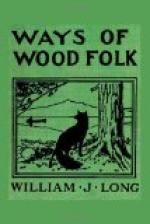Two or three hours I lay thus and watched them through the grass, spying very rudely, no doubt, into the seclusion of their home life. As the long shadow of the western hill stretched across the pool till it darkened the eastern bank, the ducks awoke one by one from their nap, and began to stir about in preparation for departure. Soon they were collected at the center of the open water, where they sat for a moment very still, heads up, and ready. If there was any signal given I did not hear it. At the same moment each pair of wings struck the water with a sharp splash, and they shot straight up in that remarkable way of theirs, as if thrown by a strong spring. An instant they seemed to hang motionless in the air high above the water, then they turned and disappeared swiftly over the eastern hill toward the marshes.
V. AN ORIOLE’S NEST.
[Illustration]
How suggestive it is, swinging there through sunlight and shadow from the long drooping tips of the old elm boughs! And what a delightful cradle for the young orioles, swayed all day long by every breath of the summer breeze, peeping through chinks as the world sweeps by, watching with bright eyes the boy below who looks up in vain, or the mountain of hay that brushes them in passing, and whistling cheerily, blow high or low, with never a fear of falling! The mother bird must feel very comfortable about it as she goes off caterpillar hunting, for no bird enemy can trouble the little ones while she is gone. The black snake, that horror of all low-nesting birds, will never climb so high. The red squirrel—little wretch that he is, to eat young birds when he has still a bushel of corn and nuts in his old wall—cannot find a footing on those delicate branches. Neither can the crow find a resting place from which to steal the young; and the hawk’s legs are not long enough to reach down and grasp them, should he perchance venture near the house and hover an instant over the nest.
Besides all this, the oriole is a neighborly little body; and that helps her. Though the young are kept from harm anywhere by the cunning instinct which builds a hanging nest, she still prefers to build near the house, where hawks and crows and owls rarely come. She knows her friends and takes advantage of their protection, returning year after year to the same old elm, and, like a thrifty little housewife, carefully saving and sorting the good threads of her storm-wrecked old house to be used in building the new.




